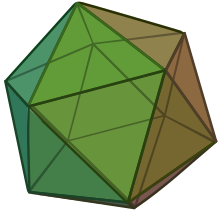Icosahedron
The best known is the (convex, non-stellated) regular icosahedron—one of the Platonic solids—whose faces are 20 equilateral triangles.
Each has 30 edges and 20 equilateral triangle faces with five meeting at each of its twelve vertices.
Its dual polyhedron is the great stellated dodecahedron {5/2, 3}, having three regular star pentagonal faces around each vertex.
In their book The Fifty-Nine Icosahedra, Coxeter et al. enumerated 59 such stellations of the regular icosahedron.
Other stellations have more than one face in each plane or form compounds of simpler polyhedra.
These coordinates represent the truncated octahedron with alternated vertices deleted.
A regular icosahedron is topologically identical to a cuboctahedron with its 6 square faces bisected on diagonals with pyritohedral symmetry.
The icosahedra with pyritohedral symmetry constitute an infinite family of polyhedra which include the cuboctahedron, regular icosahedron, Jessen's icosahedron, and double cover octahedron.







